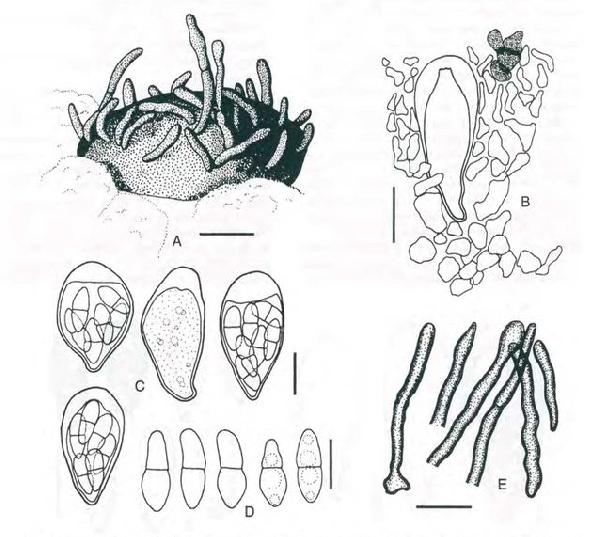Arthonia coronata Etayo
Bull. Soc. linn. Provence, 47: 95, 1996.
Synonyms:
Distribution: C - Tosc (Etayo 2002, Svensson & Westberg 2010, Brackel 2015, 2016).
Description: Thallus inapparent, not lichenized, forming discoloured patches sometimes delimited by a black line, developing inside the soralia of Flavoparmelia caperata and Cladonia-species. Apothecia arthonioid, emarginate, brown-black, punctiform, 0.05-0.1 mm across, immersed in the soralia of the host, solitary or aggregated in groups, with a rough disc covered in medium to dark brown, aseptate, cylindrical hairs with acute apices, measuring 9-37 x 3-4.7 μm. Proper exciple poorly developed, not evident; hymenium colourless to slightly yellowish, the hymenial gel I-, K/I-; paraphysoids branched and anastomosing, 2-3 μm thick; hypothecium colourless to very pale brown. Asci 8-spored, broadly clavate to subglobose, semi-fissitunicate, with a large, non-amyloid apical dome, and a distinct ocular chamber, without an amyloid ring-structure in tholus, Arthonia-type. Ascospores 1-septate, hyaline to pale brown when overmature, ellipsoid, (9-)10-14(-15) x 7-10 μm. Photobiont absent. Spot tests: K-, C-, KC-, P-. Chemistry: without lichen substances.Note: known from several European countries and from the Canary Islands, this lichenicolous fungus grows on brown-fruited species of Cladonia and, more rarely, on the soralia of Flavoparmelia caperata.
Growth form: Lichenicolous fungus
Substrata: bark, soil, terricolous mosses, and plant debris
Reproductive strategy: mainly sexual
paras Cladonia and Flavoparmelia
Commonnes-rarity: (info)
Alpine belt: absent
Subalpine belt: absent
Oromediterranean belt: absent
Montane belt: absent
Submediterranean belt: absent
Padanian area: absent
Humid submediterranean belt: very rare
Humid mediterranean belt: absent
Dry mediterranean belt: absent

Predictive model
Herbarium samples
Growth form: Lichenicolous fungus
Substrata: bark, soil, terricolous mosses, and plant debris
Reproductive strategy: mainly sexual
paras Cladonia and Flavoparmelia
Commonnes-rarity: (info)
Alpine belt: absent
Subalpine belt: absent
Oromediterranean belt: absent
Montane belt: absent
Submediterranean belt: absent
Padanian area: absent
Humid submediterranean belt: very rare
Humid mediterranean belt: absent
Dry mediterranean belt: absent

Predictive model
| Herbarium samples |
 INDEX FUNGORUM
INDEX FUNGORUM
 GBIF
GBIF


